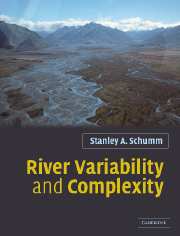Book contents
- Frontmatter
- Contents
- Preface
- Acknowledgments
- Part I Background
- Part II Upstream controls
- Part III Fixed local controls
- Chapter 9 Bedrock: alluvium
- Chapter 10 Tributaries
- Chapter 11 Active tectonics
- Chapter 12 Valley morphology
- Part IV Variable local controls
- Part V Downstream controls
- Part VI Rivers and humans
- References
- Index
Chapter 10 - Tributaries
Published online by Cambridge University Press: 05 June 2012
- Frontmatter
- Contents
- Preface
- Acknowledgments
- Part I Background
- Part II Upstream controls
- Part III Fixed local controls
- Chapter 9 Bedrock: alluvium
- Chapter 10 Tributaries
- Chapter 11 Active tectonics
- Chapter 12 Valley morphology
- Part IV Variable local controls
- Part V Downstream controls
- Part VI Rivers and humans
- References
- Index
Summary
Tributaries are a natural component of a river system (Figure 1.2). If a tributary is small, its impact upon the main channel is small, perhaps causing some minor widening and deepening. However, if the tributary is steep or large it can have effects ranging from significant widening and deepening to metamorphosis, a complete change of channel character.
When a steep sediment-laden tributary joins a main stream, the impact can be substantial (Knighton, 1987). For example, most major rapids along 450 km of the Colorado River in the Grand Canyon (Dolan et al., 1978), are caused by the sediment discharge of steep tributaries that follow faults, normal to the river. Rice and Church (1998) have identified sedimentary links in Canadian gravel-bed rivers that are the result of tributary sediment contribution. These links are a channel reach between two tributaries. The result is a series of links that repeat as a sediment fining sequence. Each link contains sediment that fines downstream with a resulting decrease of gradient. This produces a concave profile segment resulting in a cuspate longitudinal profile.
Rutherfurd (2001) describes the major impact of tributaries on Glenelg River in Victoria, Australia, which has a drainage area of 12700 km2. The tributaries supply a very large sand load to the river, which may partly block the river at the tributary junctions (Figure 10.1) and form a back-water lake upstream of the obstruction. The reverse can occur when the main channel aggrades forming lakes in the tributaries (Knighton, 1989).
- Type
- Chapter
- Information
- River Variability and Complexity , pp. 104 - 107Publisher: Cambridge University PressPrint publication year: 2005



